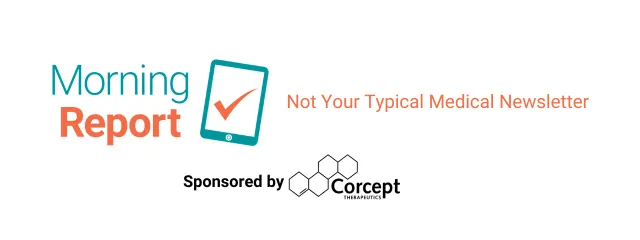
Published April 5, 2025
Morning Report — Not Your Typical Medical Newsletter
We get it, you see a lot of medical newsletters, so hear us out. Once a month, we’ll highlight important medical news sprinkled with witty commentary, fun facts, giveaways, and more… because learning should be fun! Subscribe to receive the Morning Report directly.
|
Good morning and happy spring! We’re kicking off allergy season by zooming in on its signature symptom: sneezing—or sternutation to the highbrow among us. Our grasp of the sneeze has gradually evolved since the ancients believed it expelled souls, but a decade ago, MIT’s Dr. Lydia Bourouiba blew our knowledge wide open. Bourouiba, unbothered by the nickname “the sneeze lady,” was the first to use high-speed video to capture this “violent expiratory event.” She documented “the explosive aftermath in gross detail” with the reverence of someone describing a Van Gogh sky. Key revelations:
Such findings are gradually informing public health decisions. Bless you, Dr. Bourouiba. |
Rethinking Bacterial Vaginosis Management
INFECTIOUS FINDINGS
Nearly a third of women of reproductive age grapple with bacterial vaginosis (BV), with most stuck in a relentless Groundhog Day of relapse. Despite antibiotic treatment, the infection roars back. Scientists have long sparred over the root of this stubborn resurgence, and a new study in The New England Journal of Medicine may finally deliver the smoking gun.
It takes two
What if clinicians treated women with BV and their sexual partners in tandem? That was the premise of an Australian randomized controlled trial involving 164 monogamous male-female couples. The Aussie researchers split the couples into two camps: one where women received standard care while their partners got oral and topical antibiotics, and a control group where only the women were treated.
“Crikey!” cried the Aussies, slamming the study’s emergency brake before completion. Women in the partner treatment group saw BV recurrence plummet to 35%, whereas the control crept to 63%. The verdict? BV is likely a sexually transmitted infection (STI).
What changed?
Despite years of whisperings about BV’s STI status, past studies flopped at showing efficacy with partner treatment. Why? Investigators had overlooked a crucial battleground—the penis. This study course-corrected by prescribing men not just oral antibiotics but also a topical cream for the penile skin.
Key takeaways
This study recasts BV as an STI, suggesting that cure rates hinge on clearing the infection in both partners—with oral and topical antibiotics. And while the trial focused on heterosexual couples, the findings likely extend to women in same-sex relationships. The Melbourne Sexual Health Centre wasted no time revamping its BV treatment protocols. Meanwhile, the research team—aware that global guidelines adapt at a glacial pace—launched a website to steer male partner treatment and mitigate the BV boomerang effect. Your move, CDC.
Can One Therapy Session Have a Meaningful Effect?
MENTAL HEALTH MUSINGS
One—besides being the loneliest number—is also the most common number of therapy sessions patients access for mental health care. Why? Likely because that first intake session typically hits the ground limping, drowning patients in more paperwork than a mortgage closing while delivering little real intervention. A new study highlights a shift in strategy to optimize this vital first visit.
One opportunity
“You only get one shot, do not miss your chance …”—this pearl from Eminem also defines single-session interventions, or SSIs—an acronym just one typo away from SSRIs. An SSI is a mental health program that packs meaningful support, guidance, or treatment into the one and only session patients may attend. But does it work? Investigators at Northwestern Medicine combed through 24 systematic reviews covering 415 clinical trials and found that 83% showed a beneficial effect on at least one key outcome—anxiety, depression, substance use, eating disorders, and treatment engagement.
Paradigm shift
“We’re often taught that therapy is supposed to be a journey, a lifelong process, and that ‘change never happens overnight,’” says one study author, Dr. Jessica Schleider. “While that's often true, people can also have meaningful moments or turning points within one session.” Of note, Schleider’s team at Northwestern has a vested interest. Their Project YES! program is one of the US’s flagship SSI initiatives.
Key Takeaways
SSI programs borrow from the prestige television playbook—grab your audience before they disengage. Schleider emphasizes, “If a therapist is spending their first session with somebody exclusively diagnosing them, they’ve lost the opportunity to take advantage of the first and potentially last encounter to actually do something that helps them.” While SSIs—especially digital, self-guided ones—could address a critical blind spot in mental health care, they shouldn’t erode existing support systems. Research on integrating SSIs into broader care models will guide the way. Notably, other countries, like the UK, are already ahead of the curve on implementation.
For more education on mental health in primary care, check out this CME activity: Screening for Depression and Suicide Risk in Adolescents—Do You Know What to Do?
Seven Steps for Reducing Plastic Consumption
LONGEVITY LEARNINGS
“I just want to say one word to you. Just one word—plastics.” Baby Boomers who took career advice from The Graduate made out pretty well. But the pendulum swung too far. A spoonful of microplastics and nanoplastics (MNPs) now live rent-free in the human brain, with even higher levels found in people with dementia. Plastic-free living may be unrealistic—the honey is already out of the plastic bear—but simple mitigation steps based on a recent review of the evidence may help reduce MNP intake.
Seven simple steps for minimizing MNP intake
- Switch from bottled to filtered/tap water to cut MNP intake from 90,000 to 4,000 particles/year.
- Stop microwaving food in plastic to avoid releasing billions of MNPs into meals (up to 4.22 million microplastic and 2.11 billion nanoplastic particles/cm2 in only three minutes).
- Swap plastic tea bags for loose-leaf tea to prevent leaching trillions of particles into mugs.
- Use a HEPA air filter to trap nearly 99.97% of airborne MNPs and reduce inhalation exposure.
- Store food in glass or stainless steel instead of plastic containers.
- Limit canned foods, which are lined with plastic coatings that contain bisphenol A (BPA) and can spike BPA levels by >1,000% in just five days.
- Choose whole foods over processed ones, as items like chicken nuggets contain 30 times more microplastics than chicken breasts.
To be clear:
Cutting MNP ingestion and consumption as outlined above makes sense, but clinical trials have yet to show if these steps will lead to a measurable drop in MNP buildup in the human body.
Key takeaways
MNP ingestion and inhalation can sabotage cellular function and cripple organ systems through oxidative stress, inflammation, metabolic disruption, and carcinogenesis. Worse, these particles lurk in everything from food to cleaning supplies to beauty products. But let’s reclaim the keyboard from Debbie Downer. A reassuring finding from the study is the apparent disconnect between age and microplastic buildup, hinting that the body purges MNPs through sweat, urine, and feces—despite constant environmental assault. And patients may tilt the odds further by adopting the steps above. Number one—ditch the plastic water bottle.
|
|
Interested in more healthcare news? Here are some other articles we don’t want you to miss:
- A short-term, high-caloric diet has prolonged effects on brain insulin action in men
- Scientists reveal a surprising link between ibuprofen and brain health
- Scientists discover how aspirin could prevent some cancers from spreading
- The Ozempic workout: How gyms and trainers are catering to a new group of exercisers
- New guidelines establish framework for trustworthy AI in health care
- Wireless pacifier could monitor babies' vitals in the NICU, eliminating the need for painful blood draws
- Consuming pecans as a snack improves lipids/lipoproteins and diet quality compared with usual diet in adults at increased risk of cardiometabolic diseases: a randomized controlled trial
|
Morning Report is written by:
Did You Enjoy This Issue of Morning Report? Absolutely! | For the most part | Not at all Click above, or share your feedback via email. Drop us an email at morningreport@pri-med.com to let us know how we’re doing.
Please note that the summaries in Morning Report are intended to provide clinicians with a brief overview of an article, and while we do our best to select the most salient points, we ask that you please read the full article linked in each summary for clarification before making any practice-changing decisions.
Enjoying Morning Report? Share It with Colleagues! Is Morning Report for you? It is if you’re someone who needs quick-hitting, accurate medical news—but with some flair. You don’t just need to know about the latest metabolism study—you also need to know how it parallels an Alanis Morissette hit. If you’re reading about acupuncture treatment, you need us to skip the needle puns and get straight to the point. We keep things simple, but when we do get into the scientific weeds, we always remind you to check for ticks. Subscribe to receive Morning Report directly in your inbox the first Saturday of every month.
|
